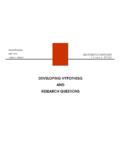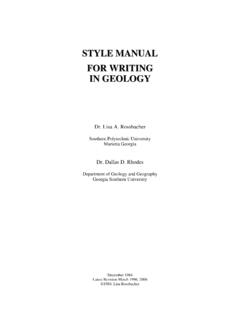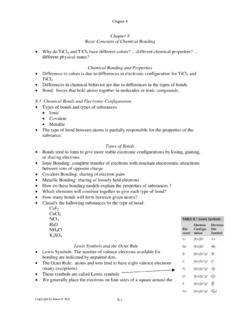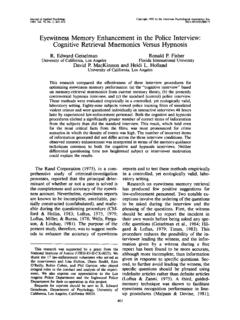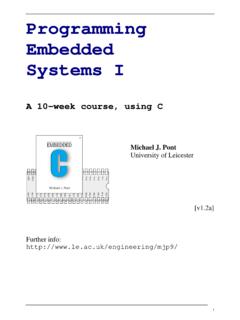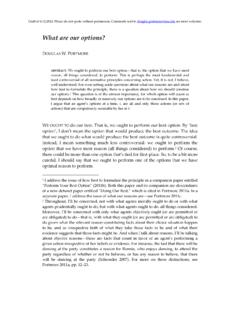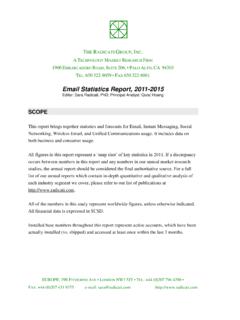Transcription of Chapter 24 Chemistry of Coordination Compounds
1 Chapter 24. Chapter 24. Chemistry of Coordination Compounds Transition metal Compounds (demo samples). variable oxidation number colored unusual composition often contain covalent Compounds bonded to the metal hydrates Lewis acid base adduct coordinate covalent bonds unusual magnetic properties The Structure of Complexes Contain coordinate covalent bonds Unusual composition: Central metal ion or atom + ligands + counter ion (if needed). Called complex ion if charged [Cu(NH3)4] ligands anion hydrate central metal ion Coordination Compounds Complex ion: [Cu(NH3)4]2+. Coordination compound : K2 CuCl4. Complex ion: [CuCl4]2 . Examples in nature: heme chlorophyll enzymes Industrial catalysts; agents in electroplating baths; extraction of metals from ores Consider , with n = 4, 5, 6.
2 How can we have Compounds with these various compositions? Dissolve in water and add AgNO3. Some Cl precipitates as AgCl immediately, some much more slowly. This indicates the relative number of Cl that are ionic or covalent. Composition Color No. Cl pptd Formula . CoCl3 6NH3 yellow 3 [Co(NH3)6]Cl3. purple 2 [Co(NH3)5Cl]Cl2. green 1 [Co(NH3)4Cl2]Cl violet 1 [Co(NH3)4Cl2]Cl The green and violet Compounds must have some further difference. 24-1. Chapter 24. All have 6 ligands ( Coordination number = 6). Contains primarily Cr(H2O)4Cl2+. On standing in solution, gives a mixture of: Cr(H2O)4Cl2+ (light green). Cr(H2O)5Cl2+ (dark green). Cr(H2O)63+ (blue gray). Can measure the ion charge by the behavior on an ion exchange column.
3 The mixture separates into colored bands on the column. Coordination Sphere Nature of Coordination Compounds is determined by both the oxidation number of the central ion and its Coordination number . The Coordination number is (mostly) constant for a metal with a given oxidation number . First Coordination sphere: central metal ion and its ligands First Coordination Sphere Coordination number is often 2 x oxidation number (many exceptions). Mostly predictable geometry: Coordination number = 2, linear Coordination number = 4, square planar or tetrahedral Coordination number = 6, octahedral Ligands Molecules or anions (rarely cations). Molecules are given the molecular name, but H2O is aqua and NH3 is ammine.
4 Anions are named with the anion name, but with an ending of o Formula and Names of Some Ligands H2O aqua NH3 ammine CO carbonyl NO nitrosyl 2 . OH hydroxo O oxo F fluoro Cl chloro . Br bromo I iodo CN cyano NC isocyano . NCS isothiocyanato SCN thiocyanato SO42 sulfato NO3 nitrato . NO2 nitro ONO nitrito CO32 carbonato H2 NCH2CH2NH2 ethylenediamine Reactions of Coordination Compounds How can we prepare Coordination Compounds or change them into other Compounds ? 24-2. Chapter 24. Redox Reactions Two possible mechanisms: Outer sphere Coordination spheres remain intact Inner sphere ligand transfer between Coordination spheres Outer Sphere [Fe(CN)6]4 + [IrCl6]2 [Fe(CN)6]3 + [IrCl6]3 . The Coordination spheres stay the same around each metal; reaction involves only transfer of an electron.
5 Inner Sphere [Co(NH3)5Cl]2+ + [Cr(H2O)6]2+ + 5H2O [Cr(H2O)5Cl]2+ + [Co(H2O)6]2+ + 5NH3. Cl is transferred from Co to Cr [Cr(H2O)5NC]2+ was prepared this way: [Co(NH3)5CN]2+ + [Cr(H2O)6]2++ 5H2O fast > [Cr(H2O)5NC]2+ + [Co(H2O)6]2+ + 5NH3. [Cr(H2O)5NC]2+ 30 sec > [Cr(H2O)5CN]2+. Substitution Reactions Replace one ligand with another Solid state reactions can be accomplished by heating [Co(NH3)5(H2O)]Cl3 [Co(NH3)5Cl]Cl2 + H2O. In solution, we can replace one ligand by another (aquation or anation or direct substitution). [Co(NH3)5Cl]2+ + H2O [Co(NH3)5(H2O)]3+ + Cl aquation [Co(NH3)5(H2O)]3+ + NCS [Co(NH3)5 NCS]2+ + H2O anation [PtCl4]2 + NH3 [PtCl3NH3] + Cl direct substitution Chelates Monodentate: attached at only one atom Polydentate: attached at two or more separated atoms ethylenediamine (en): NH2CH2CH2NH2 attaches at the two nitrogen atoms ethylenediaminetetraacetic acid (EDTA): (HOOCCH2)2 NCH2CH2N(CH2 COOH)2.
6 Attaches at up to six positions called a chelate Chelating Ligands 24-3. Chapter 24. Chelate Effect Chelating ligands give much larger values of formation constants [Ni(H2O)6]2+ + 6NH3 ! [Ni(NH3)6]2+ + 6H2O Kf = 4 108. [Ni(H2O)6]2+ + 3en ! [Ni(en)3]2+ + 6H2O Kf = 2 1018. Sequestering agents are chelating agents that are used to remove unwanted metal ions. In medicine sequestering agents are used to selectively remove toxic metal ions ( Hg2+ and Pb2+) while leaving biologically important metals. (EDTA4 ). Chelating Ligands One very important chelating agent is ethylenediaminetetraacetate EDTA is used to tie up Ca2+ in bathroom cleaners, shower sprays to prevent blood clots to remove heavy metals from the body when poisoned to solubilize iron in plant fertilizer to remove the iron taste from mayonnaise (arising from its preparation in iron vats).
7 Metals and Chelates in Living Systems The heme unit in hemoglobin involves a rigid chelating ligand. H2O or O2 or CO can be the 6th ligand. Chlorophyll, involved in photosynthesis, is a complex ion of magnesium(II) ion. Nomenclature of Coordination Compounds Nomenclature follows different rules than for normal inorganic Compounds Name the cation and the anion separately Follow the same rules for Coordination Compounds and complex ions. Rules for Nomenclature 1. Name the cation, then the anion. 2. Nonionic Compounds are given a one word name. 3. Name ligands: a. ligands are named first and central atom last b. ligands are named in alphabetical order c. neutral ligands are named the same as the molecule (except aqua and ammine).
8 D. anionic ligands are named by adding o to the stem of the name (chloride becomes chloro). e. the ligand name is preceded by a Latin or Greek prefix to indicate how many are present di, tri, tetra, penta, hexa if one of these is part of the ligand name, use bis, tris, tetrakis, pentakis, hexakis 4. In a neutral or cationic complex, the name of the central metal is followed by its oxidation number in Roman numerals in parentheses. 5. In an anionic complex, the suffix ate is added to the name of the central metal, followed by its oxidation number in Roman numerals in parentheses. 24-4. Chapter 24. Nomenclature Apply the rules to the following Compounds . [Cr(H2O)5Cl]SO4 pentaaaquachlorochromium(III) sulfate 2+.
9 [Cr(H2O)5Cl] pentaaquachlorochromium(III) ion [Cr(H2O)4Cl2]Cl tetraaquadichlorochromium(III) chloride [Cr(H2O)4Cl2]+ tetraaquadichlorochromium(III) ion [Cr(NH3)3Cl3] triamminetrichlorochromium(III). K2[PtCl4] potassium tetrachloroplatinate(II). [PtCl4]2 tetrachloroplatinate(II) ion [Co(en)2Cl2]Cl dichlorobis(ethylenediamine)cobalt(III) chloride tetraamminecopper(II) sulfate [Cu(NH3)4]SO4. potassium hexacyanoferrate(II) K4[Fe(CN)6]. hexaamminechromium(III) hexachloroiridate(III) [Cr(NH3)6][IrCl6.. diaquabromochlorofluoroiodochromate(III) ion [Cr(H2O)2 BrClFI] . Group Work: Name these Compounds [Co(NH3)4(H2O)F]2+. [Cu(en)2]2+. [Pt(NH3)Cl3] . [Cu(en)2][PtCl4]. Isomerism Isomers two or more forms of a compound having the same composition Isomers Structural isomers (different bonding).]
10 Ionization isomer hydration isomers } Coordination sphere isomers linkage isomers Stereoisomers (identical bonding). geometrical isomers optical isomers Structural Isomers Different ligands or different attachment of ligands Ionization Isomers exchange ion between ligand and anion [Co(NH3)4 ClBr]Cl and [Co(NH3)4Cl2]Br [Pt(NH3)3Cl]NO2 and [Pt(NH3)3NO2]Cl Group Work: Write the formula of an ionization isomer of [Co(NH3)4(NO2)2]Br. Hydration Isomers exchange water as ligand and hydrate [Cr(H2O)6]Cl3, [Cr(H2O)5Cl] , and [Cr(H2O)4Cl2] [Co(NH3)5(H2O)]Cl3 and [Co(NH3)5Cl] 24-5. Chapter 24. Group Work: Write the formula of a hydration isomer of [Pt(NH3)4Cl2] Linkage Isomers ligands that can bond at more than one atomic site (ambidentate).

